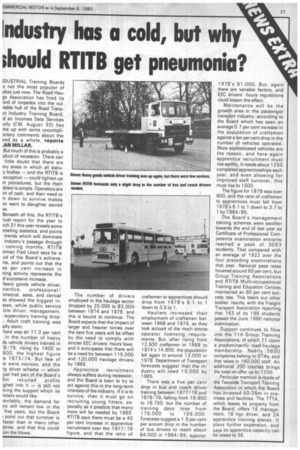Industry has a cold, but why ;hould RTITB get pneumonia?
Page 29

If you've noticed an error in this article please click here to report it so we can fix it.
IDUSTRIAL Training Boards e not the most popular of idies just now. The Road Hauge Association has fired its Lind of torpedos into the vulTable hull of the Road Transirt Industry Training Board, d an Incomes Data Services udy (CM. August 30) has me up with some uncompli?ntary comments about the eed as a whole, reports AN MILLAR.
But much of this is probably a )duct of recession. There can little doubt that there are my areas in which all statuy bodies — and the RTITB is exception — could tighten up
!ir procedures, but the main )blem is simple. Operators are )rt of cash, and their need to -n down to survive makes rn want to slaughter sacred vs.
Beneath all this, the RTITB's mai report for the year to rch 31 this year reveals some ?resting statistics, and points trends which will dominate industry's passage through coming months. RTITB iirman Fred Lloyd says he is ud of the Board's achievents, and points out that the ee per cent increase in ning activity represents the d successive increase.
-leavy goods vehicle driver,
)rentice, professional! -imercial, sales, and clerical as showed the biggest inases, while public service icle driver, management, supervisory training drop. Adult craft training was idly static.
'here was an 11.3 per cent in the number of heavy ds vehicle drivers trained in 8/79, rising by 1400 to 800, the highest figure :e 1973/74. But few of ;e were novices, and the ig driver scheme — which just had part of the Board's 5m recycled profits • ghed into it — is still not lying the support which its noters would like.
ievitably, the demand for ?rs will remain low in the five years. but the Board ; point out that turnover is faster than in many other stries. and that this could ion the blows. The number of drivers employed in the haulage sector dropped by 25.000 to 83,000 between 1974 and 1978, and this is bound to continue. The Board expects that the impact of larger and heavier lorries over the next five years will be offset by the need to comply with stricter EEC drivers' hours laws. and it anticipates that there will be a need for between 115,000 and 120,000 haulage drivers by 1985.
Apprentice recruitment always suffers during recession, and the Board is keen to try to act against this in the long-term interests of the industry. If it is to survive, then it must go on recruiting young fitters, especially as it predicts that many more will be needed by 1985. RTITB says there must be a 40 per cent increase in apprentice recruitment over the 1977/78 figure, and that the ratio of craftsmen to apprentices should drop from 1978's 6.1 to 1 down to 3.5 to 1.
Hauliers increased their employment of craftsmen between 1968 and 1974, as they took account of the much stricter operator licensing requirements. But, after rising from 12,500 craftsmen in 1968 to 1974's 14,800, the population fell again to around 13,000 in 1978. Department of Transport forecasts suggest that the industry will need 15,000 by 1985.
There was a five per cent drop in bus and coach driver training between 1977/78 and 1978/79, falling from 19,800 to 18,750, but the number of training days rose from 179,000 to 199,000. Forecasts suggest a 1.5 per cent per annum drop in the number of bus drivers to reach about 84.000 in 1984/85, against 1978's 91,000. But, again there are variable factors, and EEC drivers' hours regulations could lessen the effect.
Maintenance will be the growth area in the passenger transport industry, according to the Board which has seen an average 0.7 per cent increase in the population of craftsmen against a ten per cent drop in the number of vehicles operated. More sophisticated vehicles are the reason, and here again apprentice recruitment must rise swiftly. It needs about 1250 completed apprenticeships each year, and even allowing for improved staff turnover, this must rise to 1500.
The figure for 1978 was over 800, and the ratio of craftsmen to apprentices must fall from 1978's 6.1 to 1 down to 3.7 to 1 by 1984/85.
The Board's management training schemes were swollen towards the end of last year as Certificate of Professional Competence examination entrants reached a peak of 3093 students. That compared with an average of 1922 over the four preceding examinations that year. National pass rates hovered around 60 per cent, but Group Training Associations and RTITB Multi-occupational Training and Education Centres maintained an 80 per cent success rate. This bears out other bodies' results, with the Freight Transport Association reporting that 163 of its 198 students passed the June 1980 national examination Support continues to flow into the 114 Group Training Associations, of which 71 claim a predominantly road-haulage membership. Nearly 3600 companies belong to GTAs, and that takes in 160,000 staff. An additional 200 courses brings the total on offer up to 1700.
Particular mention is made of the Teesside Transport Training Association in which the Board has invested £0.25m in premises and facilities. The TTTA, which leases its property from the Board, offers 16 management, 18 hgv driver, and 24 apprentice training places. It plans further expansion, and says its apprentice capacity can be raised to 36.




































































































































